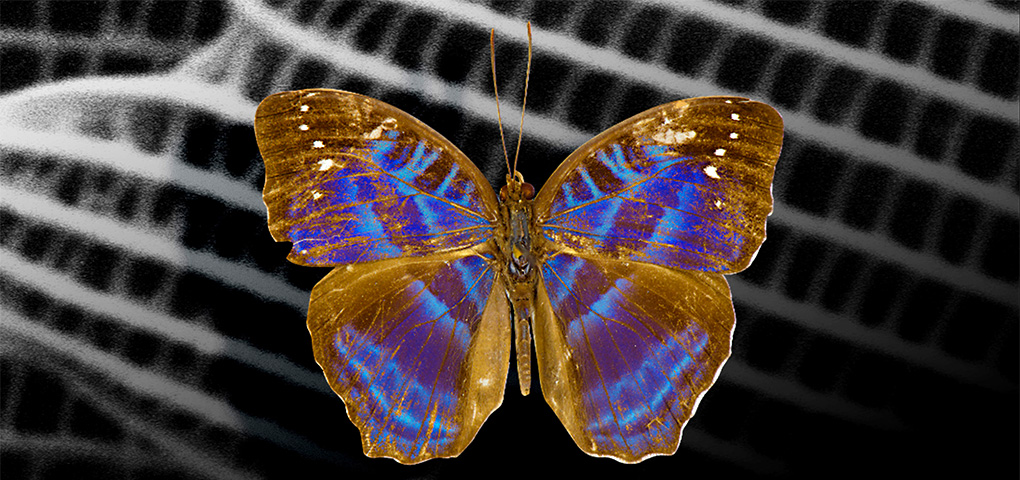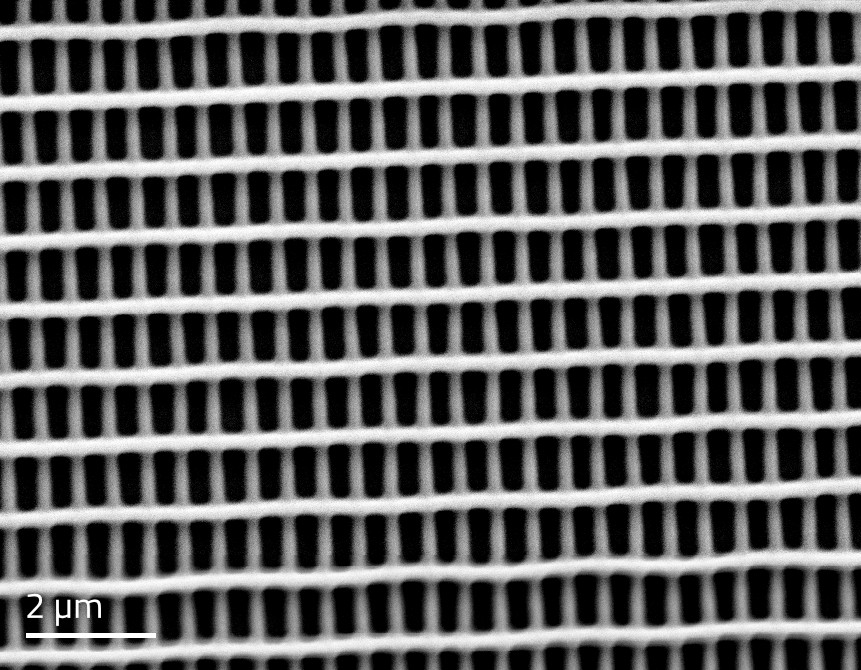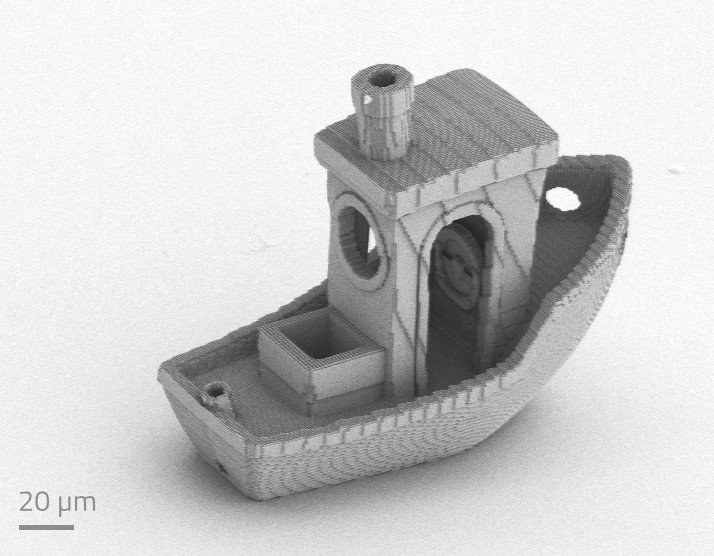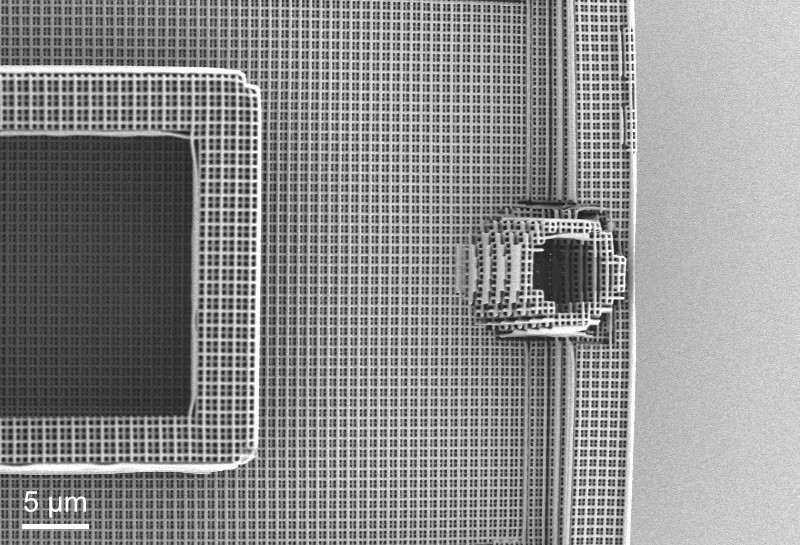There is a strong interest in studying structural color because in nature this effect occurs in a variety of forms. For example, butterfly wings are of particular interest due to their vibrant and iridescent structural colors. Unlike synthetic dyes and pigments, structural coloration offers advantages such as brightness, usually angle dependence, stability in terms of fade resistance and its environmental friendliness. Nanoscribe’s additive manufacturing technology based on Two-Photon Polymerization (2PP) enables the precise and reliable fabrication of nature-inspired structures that generate structural colors. Exploiting the outstanding spatial resolution of 2PP-based 3D printing down to the submicron range, the dependence of structural colors on various structural parameters can be experimentally investigated.
Mimicking butterfly colors with bigrating structures
The wings of the "Cynandra opis" butterfly generate blue iridescence. Inspired by this, scientists at the ETH Zurich led by Professor Andrew deMello produced bigrating nanostructures that mimic those contained in the butterfly’s wings. The 3D structures consist of two grid layers stacked perpendicular to each other, also known as a ‘crossed double-grating’ structure. Such a structure consists of two diffractive planes, with an array of ridges forming the first, and a perpendicular array of ridges below this forming the second. These orthogonal planes can diffract light in both the x and y directions. The combined effects of diffraction and interference generate coloration.
Planar colors with 3D-printed nanostructures
Based on these observations, the scientists designed and 3D-printed bigrating nanostructures with different parameters. In this way, they were able to investigate the influence of incident angle, period and height on the structural coloration. Variations in the feature period and/or height of the ridges affected both hue and color purity. The transparent substrate used to print the structures allowed the researchers to illuminate the structures from behind to create the coloration effect under different incident angles. Variations in the grating period between the first and second planes, while keeping the grating height constant, resulted in the generation of a full range of color pixels in a plane covering the visible spectrum. This type of bigrating structure was used to print a meter-sized image scaled down as a thumbnail image with millimeter dimensions and micrometer pixel size. Such multicolor structures are likely to find applications, for example, in digital 3D displays, color filtering and high-density data storage such as in micro image displays.
3D shapes with structural colors
Moving from planar structural coloration to 3D objects that reflect structural colors is still a challenge. However, structural colors in 3D exploit the freedom to shape, control and display colors beyond the limitations of their 2D counterpart. Woodpile photonic crystals are promising structures that can be used as building blocks to form 3D shapes that display structural colors. However, these colors are generated when woodpile photonic crystals (WPC) are illuminated from the top and to achieve visible stop bands along the stacking direction, structural resolutions below 500 nanometers in all spatial directions are required. Manufacturing these structures with direct laser printing is challenging. Structural resolution can be improved, for example, by using advanced systems and novel materials or by post-processing steps such as heat shrinking.
2PP-based printing of 3D structural colors
Researchers from the Agency for Science, Technology and Research A*STAR in Singapore, the Singapore University of Technology and Design and the Nanyang Technological University collaborated on a new strategy for using woodpile photonic crystals to create 3D structural colors: They investigated theoretically and experimentally the woodpile photonic crystals band structures under lateral illumination. A one-step printing process that avoids post-processing steps and the need to print subwavelength lattice constants was used to fabricate the WPCs.
Using Nanoscribe’s Two-Photon Polymerization, it was possible to fabricate a wide range of WPCs with varying in-plane (from 750 to 1,300 nanometers) and out-of-plane (from 900 to 1,400 nanometers) pitches. The height of the rods is 380 nanometers while the width is 130 nanometers. With this very small rod width, the WPCs generate high reflectance of bright structural colors, reaching up to 50% reflectance. This approach resulted in WPCs that reflected a wide range of colors, from blue, cyan, green, green-yellow, yellow, to red and purple. The vivid colors generated by these structures cover more than 85% of the sRGB color space and exhibit excellent color purity.
Tunable colored 3D shapes
The researchers also validated the printing of arbitrary 3D shapes with coloration. They 3D-printed the Merlion, the iconic mascot of Singapore, and a 3DBenchy model, known as a benchmark for 3D printing performance. These 3D shapes are colorful, demonstrating the ability to tune the colors of different parts of the 3D shapes. Precise color tuning at the voxel level was achieved by simultaneously changing in-plane and out-of-plane pitches even in intricate geometries. The colors reflected by these structures enable both gradual and abrupt color changes. These findings will open up new applications for 3D freeform structural colors in fields such as coloration-based sensors, color displays, light emitting devices and anti-counterfeiting applications.
Interested to read more about how Two-Photon Polymerization is used to print structural colors? Here you will find the full articles on Bioinspired "Cynandra opis" butterfly’s structural colors and 3D structural colors by 3D-printed woodpile photonic crystals.
This and further scientific publications on more than a thousand research projects from Nanoscribe customers and system users can be found in a powerful database with a keyword search in the Premium Resources section. Register for free to see for yourself the potential of Nanoscribe’s 3D Microfabrication technology for innovative applications and fundamental innovations in many areas, and to evaluate its suitability for your project.





